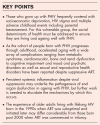Aging of adult lifetime survivors with perinatal HIV
- PMID: 40392284
- PMCID: PMC12147760
- DOI: 10.1097/COH.0000000000000938
Aging of adult lifetime survivors with perinatal HIV
Abstract
Purpose of review: We describe the emerging clinical outcomes for adults born with perinatally acquired HIV (PHIV), who have been living with HIV throughout their life. Whilst many comorbidities appear similar to adults with horizontally acquired HIV, they manifest at a younger chronological age. The additional impact of HIV throughout postnatal, childhood and adolescent growth and development requires further consideration.
Recent findings: There is growing evidence of an increased incidence of metabolic, cardiovascular, respiratory, bone and renal impairment as well as structural brain changes associated with impaired cognitive function, and mental health disorders; early case series data suggests a six-fold increased prevalence of psychosis for those with lifelong HIV compared with age-matched peers. Older age, prior CDC-C diagnoses and lower nadir CD4 count confer the greatest risk of PHIV complications in adulthood, but biological factors are compounded by socioeconomic deprivation, bereavement, HIV-associated stigma, discrimination and immigration. The aetiology of these increased comorbidities is yet to be fully elucidated but includes lifelong systemic inflammation and immune dysfunction despite suppressive antiretroviral therapy (ART).
Summary: Adults living with lifelong HIV experience increased risk of comorbidities at a younger chronological age despite viral suppression on ART. Exploring the aetiology and characterizing the clinical manifestations of lifelong HIV can best inform screening tools and interventions that can enhance quality of life and longevity.
Keywords: comorbidities; lifelong HIV; mental health; perinatally acquired HIV; sexual health and pregnancy; young adults.
Copyright © 2025 The Author(s). Published by Wolters Kluwer Health, Inc.
Conflict of interest statement
Similar articles
-
Multisystem impairment in South African adolescents with Perinatally acquired HIV on antiretroviral therapy (ART).J Int AIDS Soc. 2019 Aug;22(8):e25386. doi: 10.1002/jia2.25386. J Int AIDS Soc. 2019. PMID: 31441211 Free PMC article.
-
Ageing with HIV: a longitudinal study of markers of resilience in young adults with perinatal exposure to HIV, with or without perinatally acquired HIV.J Int AIDS Soc. 2022 Sep;25 Suppl 4(Suppl 4):e25982. doi: 10.1002/jia2.25982. J Int AIDS Soc. 2022. PMID: 36176020 Free PMC article.
-
Differences in clinical characteristics between adolescents and young adults with perinatally and sexually acquired HIV in the Asia-Pacific region.J Int AIDS Soc. 2025 Apr;28(4):e26400. doi: 10.1002/jia2.26400. J Int AIDS Soc. 2025. PMID: 40200597 Free PMC article.
-
Cardiometabolic Complications in Youth With Perinatally Acquired HIV in the Era of Antiretroviral Therapy.Curr HIV/AIDS Rep. 2021 Oct;18(5):424-435. doi: 10.1007/s11904-021-00574-x. Epub 2021 Oct 15. Curr HIV/AIDS Rep. 2021. PMID: 34652624 Free PMC article. Review.
-
Understanding the mental health of youth living with perinatal HIV infection: lessons learned and current challenges.J Int AIDS Soc. 2013 Jun 18;16(1):18593. doi: 10.7448/IAS.16.1.18593. J Int AIDS Soc. 2013. PMID: 23782478 Free PMC article. Review.
References
-
- The Urgency of Now: AIDS at a Crossroads [Internet]. Geneva: Joint United Nations Programme on HIV/AIDS (UNAIDS); 2024. Available at: https://www.unaids.org/en/resources/documents/2024/global-aids-update-2024. [Accessed 25 February 2025].
-
- Foster C, Ayers S, Mcdonald S, et al. . Clinical outcomes post transition to adult services in young adults with perinatally acquired HIV infection: mortality, retention in care and viral suppression. AIDS 2020; 34:261–266. - PubMed
-
- Abd-Elmoniem KZ, Yeramosu T, Purdy JB, et al. . The role of HIV as a risk modifier for coronary endothelial function in young adults. HIV Med 2023; 24:818–826. - PubMed
Publication types
MeSH terms
LinkOut - more resources
Full Text Sources
Medical
Research Materials


